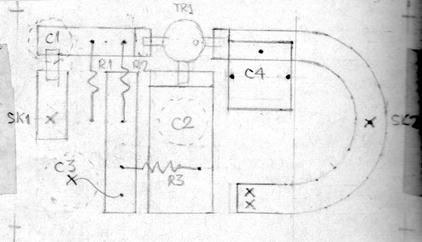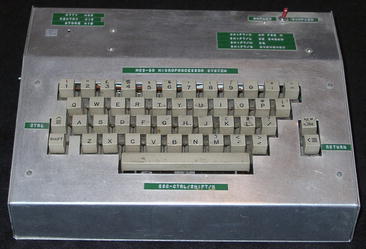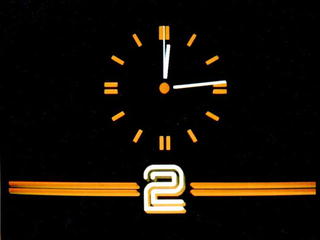My Career in the BBC, Part 1
by Richard Russell
I joined Designs Department in 1973, straight from university (Hertford College, Oxford). This was my first full-time job, my only previous 'paid' employment having been some vacation work in the Clarendon Laboratory.
RF Section
|
|
|
My very first PCB layout |
After the obligatory Induction Course at Wood Norton I began my stint as a Graduate Trainee in Section 5 (RF Section), led at the time by Johnny Johnstone. My first red 'lab book' reminds me that I was asked to build a UHF amplifier using a single BFR90 transistor (it worked, but had a much narrower bandwidth than intended) followed by tests on some new Mullard wide-band RF amplifier modules, the OM175 and OM180. Several more projects in RF Section followed, although (despite being a radio amateur) I never felt entirely at ease at these high frequencies. Perhaps this is why I spent some time in the section designing regulated DC power supplies!
Monitoring & Control Section
In 1975 I moved from Section 5 to Section 2 (Monitoring and Control, led by John Shelley). However the change of section didn't much alter the nature of the work as my first project was another regulated DC power supply! My real enthusiasm was for digital logic and it wasn't long before I had the opportunity to put it to good use. I joined David Carter's team who were developing the Monitoring and Information Centres (M.I.C.) that would receive messages from the Automatic Fault Reporters at unattended transmitter sites and collate them at a central point such as a main transmitter (the first was to be at Kirk O'Shotts in Lanarkshire). My initial task in the project was to design the Fault Directory (for converting numeric codes to text messages) and Printer Interface (to print a log of all faults as they occurred and were subsequently cleared). I was later involved with the Lower VDU and MCP Interface.
PROM Programming
|
|
|
The 1702A 256-byte EPROM |
The M.I.C. Fault Directory consisted of a large (for the time!) read-only-memory store based on the new FAMOS (Floating-gate Avalanche MOS) UV-erasable PROMs - what we would now call EPROMs. We considered these devices, each of which stored 256 bytes, little short of miraculous! Not only would they, we were assured, hold their data for several years but they could be erased (by exposure to short-wavelength UV light) and re-programmed over and over again; they were also the first devices we had encountered with a transparent window allowing you to see the chip inside.
These devices were so new that commercial programmers were not yet available so I was given the job of designing and building one. This was no easy task, because the programming specification was extremely complicated, involving ramping the voltages on various pins up and down at controlled rates and between strange levels; I remember that the –47 Volt (yes, really!) logic signals on the eight data pins had to be inverted at a critical point in the programming cycle. In addition, the entire sequence of 256 addresses had to be cycled through many times before the device was fully programmed. Since the programmer had no storage of its own, this was achieved by punching the required data onto paper-tape, splicing the tape into a loop and running it through a tape reader the requisite number of times. It was with great trepidation that I first attempted to program a device (I think at the time we had only two) knowing that if anything was slightly wrong the expensive PROM would almost certainly be destroyed. Fortunately it worked perfectly and the programmer was subsequently used to program the entire M.I.C. Fault Directory, needing about 32 PROMs per system.
My involvement in PROM programming was to continue, on and off, for the rest of my BBC career. This included selecting commercial programmers, once they had become available (initially an American Pro-Log device and later programmers made by the British company Stag), writing software to control them and devising file formats for archiving PROM and PAL data.
Odds and Ends
At around this time I was appointed to the post of Design Engineer in Monitoring and Control Section, so I was able to continue with the work I had been doing without the worry of being moved on or failing to achieve a substantive post. For the next couple of years I worked on various projects including a system for signalling data via Band II FM transmissions using a phase-modulated 76 kHz subcarrier (MD1/6 and DM1/5), a switched-mode power supply (PS4/4), two MSF clocks - one for the M.I.C. (CO4/3) and the other for Ceefax (GE7/7) - and an 'invigilating sync monitor' for the Outside Broadcast vision mixer (EP11/502). The last of these had the task of sequencing through all the inputs to the mixer to check if they were properly synchronised, and sending the appropriate Natlock audio tones to the remote source to correct any timing error.
Microprocessors
|
|
|
My first computer |
None of my projects thus far had used microprocessors, although I had much earlier built my own 8080-based computer from a kit (at the time such things were expensive and I remember the distributor from whom I bought it saying it was the first they had sold to a private individual). Using this computer, which I subsequently brought to work, I had become a competent assembly-language programmer. In 1977 I joined a project that would allow me to put this software expertise to use: this was Bennfax (more formally the Scenery Department Electronic Notebook) named after the then Head of Scenery Department Eric Benn who commissioned it.
For the Bennfax project, and the closely related Presfax, John Oakley and I developed a range of standard modules that could be used in various configurations to construct microprocessor-based systems. These modules included EPROM (UN27/1), RAM (UN27/7, later UN27/13), Z80 CPU (UN26S/31), VDU (GE8/501, later GE8/505) and floppy-disk interface (CO10/2). This range of standard modules was christened Zeus, standing for Z-Eighty Universal System, and it became the basis for many later projects. Not least of these was an in-house software-development system called Zelda (Z-Eighty Linker, DOS and Assembler), based on a previously purchased Mostek development system.
Clocks and Logos
|
|
|
John Shelley's original note |
One project to use these modules was the first fully-electronic Network Clock, GE1M/597. This project was initiated in 1979 after John Shelley had seen an Engineering Weekly Information Sheet outlining problems in keeping the 'clock camera' correctly adjusted. John sent me a note saying simply "This all seems pretty primitive. Is there a possibility that we could generate the clock caption electronically?". It didn't take me long to work out a way in which the clock hands (hour, minute and second) could be synthesised using digital logic at all the different angles needed, although the shapes could be no more complicated than long thin rectangles. One problem was that, at shallow angles, the edges of the hands had very noticeable 'steps' (what we would now call aliasing, although at the time I wasn't familiar with the term). This was solved using a rather crude analogue technique of generating linear ramps with different slopes depending on the angle of the hand.
|
|
|
The BBC's first electronically generated clock |
In conjunction with a separate unit (GE6/545) to generate the 'static' parts of the clock display (numerals and channel ident) the electronic clock was used on both BBC1 and BBC2 (typically before news broadcasts) for about ten years, eventually to be replaced in 1990 by the much more sophisticated and fully-digital GNAT clock (Generator Network Analogue Time, otherwise the GE6SM/574) also designed by me. A spin-off from the earlier clock design was an electronic clock and logo generator for the British Forces Broadcasting Service and it arguably started the trend for other Digitally Originated Graphics such as MOUSE (the Moving Open University Symbol Equipment), the animated BBC2 logo, BAT (Breakfast Analogue Time) and eventually the electronic rotating world (OWL) and Test Card F generator, although I wasn't directly involved with the development of those.
BBC Microcomputer
In 1980 the BBC embarked on its Computer Literacy Project with the ambitious aim of educating the general public in the use of computers. This project, which was to have profound consequences (not least on the future course of my life) culminated in 1982 with the broadcast of The Computer Programme and the marketing of the BBC Microcomputer. I had been involved from an early stage (along with David Kitson) as the main technical representative on the committee charged with choosing a manufacturer and producing a specification. Once Acorn had been selected to design and manufacture the machine, I was involved with agreeing the specification of BBC BASIC, evaluating prototypes and, in collaboration with David King, designing and testing the machine's Cassette Filing System. Once the machine was on sale I had an ongoing role in monitoring its technical performance and specifying the various expansion options (Teletext Adaptor, Second Processors etc.) as well as being consulted on future developments (Acorn Electron, BBC Master etc.).
In parallel with this work I had been upgrading the BBC's Zelda system to run CP/M and my Z80 version of BBC BASIC. It's a little known fact that the pre-recorded software data cassettes produced by BBC Publications were not recorded from the output of a BBC Micro but instead from a special piece of equipment, based on Zeus units, programmed in BBC BASIC (Z80)! This had a much better analogue output stage than the BBC Micro, and produced tapes which had a reputation for reliability even after mass duplication.
Although my direct involvement had pretty much ceased by the time the Acorn Archimedes came out (1987) my association with the Computer Literacy Project in general and BBC BASIC in particular had given me the opportunity to branch out, independently of the BBC, in my private capacity (having received David Kitson's kind permission to do so) as outlined in my History of BBC BASIC.
Domesday Project
In 1983 the BBC started planning its Domesday Project which was another ambitious exercise, intended to coincide with the 900th anniversary in 1986 of the original Domesday Book. The idea was to construct a database (analogous with the contents of the original book) consisting of text, photographs and maps covering the entire country, much of it collected by schools. Once collated this would be recorded onto an optical disk and read by a laser disk player (specially adapted to read data as well as pictures) in turn controlled by a BBC Microcomputer. The intention was that these players would be made available in schools and libraries, providing a snapshot of life in Britain in November 1986.
Because of my previous involvement with the BBC Micro I was once again co-opted as a technical adviser to the project, although the main engineering input on this occasion came from Philips and Acorn.
HF Automation
In about 1981 I joined David Carter's team to develop an automation system for the BBC's HF (short wave) transmitting station at Woofferton, Shropshire; the other team members were David King, Nick Cutmore and John Went. This was to be based on the Zeus range of modules, although extra units had to be developed because of the need to interconnect several pieces of equipment in a harsh electromagnetic environment. David Carter conceived a solution based on a ruggedised network called the Hub which would provide communication between the various parts of the system.
|
|
|
Commemorative trophy 1988 |
My role in the project was to design the hardware and software for the User Interface, otherwise known as the VDU. This used dual 8" floppy disk drives to store the schedule information (listing when each transmitter should be switched on, on what frequency, using which antenna and fed from which incoming programme chain). The operator was able to enter and edit the schedule on a VDU screen, transfer it into the rest of the system (e.g. sender controllers) and, if necessary, issue commands for immediate execution such as short-notice amendments to the schedule. This was a complex system but, as with all real-time software of the period, programmed entirely in assembly language.
The system was successfully installed at Woofferton and later, with a few modifications under the leadership of Martin Ellen, at Skelton in Cumbria. This led to a requirement for a Mark II version for installation at the BBC's other short wave stations in the UK (Rampisham and Daventry) and overseas (Seychelles and Hong Kong). For this development phase the project had been taken over by David King and three more engineers, Alan Tresadern, Brandon Butterworth and Glyn Morgan, joined the team. The completion of the project was celebrated in 1988 with the distribution of commemorative trophies to the team members. The Daventry site has since been closed down but most of those systems are (at the time of writing) still running, 24 hours a day, over sixteen years later.
Ups and Downs
Not all my projects in Designs Department were entirely successful. A low point came in 1980 when I designed an interface between the Omega OSM5 Swim-o-Matic sports timer and a video character generator, the purpose of which was to superimpose lane numbers and times during televised swimming events. Unfortunately my design had a flaw, whereby every so often a collision would take place on a data bus, causing the timing data to be corrupted. If this happened during the course of a race it would result only in a momentary glitch in the displayed caption, however if it happened just as the leading swimmer reached the finish line it could affect the displayed winning time. Although statistically unlikely, luck was not on my side: I was at home watching the first, live, use of the equipment on-air when this very thing happened in one of the races. It was embarrassing to listen to the commentator apologise for the erroneous display, whilst the director hurriedly faded it out!
However this seems to have been forgotten by 1986 when I was promoted to the post of Senior Design Engineer, heralding a period when I would be involved in running large projects with teams of Design Engineers working for me. These included the GNAT clock (GE6SM/574) and the BBC Select scrambling encoder (CD2SM/532). However these projects happened after Designs Department, as such, had ceased to exist, having been merged with Equipment Department in 1987.




